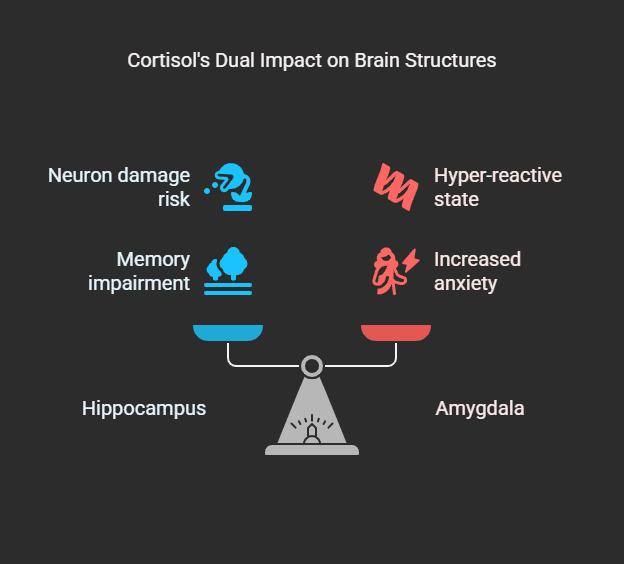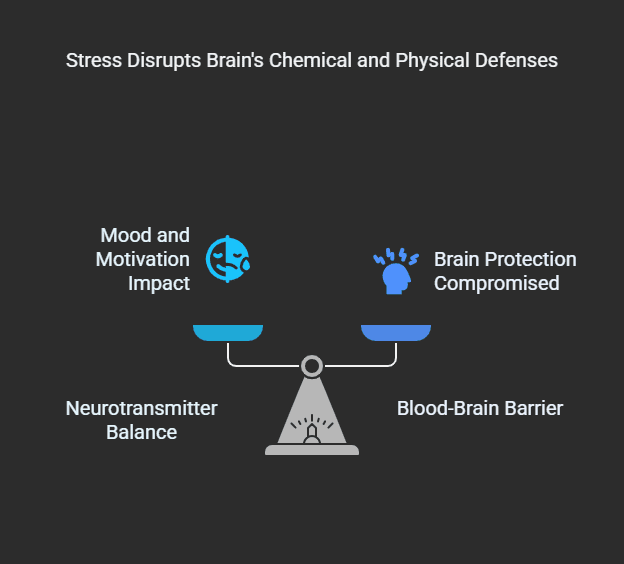We’ve all felt that way – the pounding heart, the hunched shoulders, the racing thoughts with a million things to fret about. In our high-speed world, stress feels like a necessary evil. Yet although a small amount of stress can be energizing, ongoing, relentless stress has a big impact, especially on our most important organ: the brain. The good news? We’re not helpless. By learning how stress impacts us and adopting practical strategies, we can proactively work to Stress Less, Think Clearer, protecting our mental acuity and fostering overall health. This article delves into the science of stress and its effects on brain health, with a special emphasis on the effects of the stress hormone cortisol. More importantly, we’ll look at practical, evidence-based mindfulness and stress-reduction techniques – such as meditation, deep breathing, and spending time in nature – that you can incorporate into your life to develop calmness, improve mental clarity, and create a more resilient brain.
The Brain Under Siege: How Chronic Stress Sabotages Your Mind
Our bodies possess an extremely advanced mechanism for coping with perceived threats – the “fight-or-flight” response. When under threat (whether it’s an ancient predator or a deadline looming on your calendar), the brain invokes the release of hormones, including mainly adrenaline and cortisol, which are controlled by the Hypothalamic-Pituitary-Adrenal (HPA) axis.
- Adrenaline: Provides that quick energy rush, boosting heart rate and wakefulness.
- Cortisol: The major stress hormone of the body raises blood sugars (glucose), boosts your brain’s glucose use, and makes substances available that repair tissues. Cortisol also suppresses functions that would be unnecessary or even harmful in a fight-or-flight situation, such as modifying immune system functions and dampening the digestive system, reproductive system, and growth processes.
This system is great for survival in the short term. The issue is when the stressor is not a temporary danger but an ongoing presence – financial stress, work pressure, relationship tension, information overload, or even chronic negative thought patterns. When the HPA axis is continuously stimulated, we have chronic stress, which means we have prolonged exposure to high levels of cortisol.
The Cortisol Effect: Slow Damage to Key Brain Areas

Though needed in brief spurts, chronically elevated cortisol levels become brain-toxic, affecting structure, function, and health in several important ways:
- Reducing the Hippocampus: This seahorse-shaped structure, far within the brain, plays a vital role in learning, the formation of memories (particularly the transfer of short-term to long-term memories), and spatial orientation. Studies repeatedly indicate that long-term exposure to elevated cortisol levels can harm and kill hippocampal neurons and inhibit the growth of new neurons (a process referred to as neurogenesis). This can result in problems with recalling memories, learning new things, and even cause mood disorders such as depression.
- Expanding the Amygdala: The amygdala is the fear center of the brain, involved in processing fear, anxiety, and aggression. Ongoing stress can make the amygdala larger and more active. This hyper-sensitizes the brain to stress, making it go into a hyper-reactive mode where you get easily triggered, anxious, and afraid. It conditions the brain for an increased stress response, producing a self-reinforcing cycle.
- Damaging the Prefrontal Cortex (PFC): Located in the front of the brain, the PFC is our executive control hub. It directs sophisticated cognitive skills such as decision-making, planning, problem-solving, working memory, attention, social conduct, and emotional self-regulation. Elevated cortisol damages weaken ties to the PFC while energizing ties to the more basic amygdala and hippocampus. This adaptation can appear as:
- Difficulty sustaining concentration and attention
- Poor judgment and impulsive decision-making
- Decreased working memory capacity (easier to forget information).
- Troubles with managing emotions and impulses.
- Trouble with planning and organization.
- Interfering with Neurotransmitter Balance: Long-term stress can get in the way of the subtle balance between brain chemicals (neurotransmitters) such as serotonin (mood), dopamine (reward and motivation), and GABA (anxiety-reducing effect), and cause anxiety, depression, and decreased feelings of pleasure or motivation.
- Increasing Inflammation: Chronic stress promotes low-grade inflammation throughout the body, including the brain. Neuroinflammation is increasingly linked to cognitive decline, neurodegenerative diseases like Alzheimer’s, and mental health disorders.
- Disrupting the Blood-Brain Barrier (BBB): The BBB is a barrier that protects and regulates what is passed from the blood to the brain. Its integrity can be impaired by chronic stress, allowing toxic substances to enter and lead to inflammation and further damage

.Essentially, chronic stress not only makes you feel stressed; it changes your brain in ways that erode your capacity to think, remember well, Slow Damage to Key Brain Areas. This underscores the essential value of proactive stress management for long-term brain function and mental vitality.
Reclaiming Your Calm: Actionable Techniques to Stress Less, Think Clearer
Understanding the issue is step one. The second, more empowering step, is action. Fortunately, many effective methods based on mindfulness and physiological regulation can counteract the adverse effects of stress, soothe the nervous system, and foster a healthier brain environment.
- Mindfulness Meditation: Training Your Attention Muscle
Mindfulness is the act of bringing attention to the current moment – your thoughts, emotions, body sensations, and environment – deliberately and without judgment. Meditation is a structured method of developing this ability.
How it Aids the Brain: Consistent meditation practice has been found to cause beneficial structural and functional changes in the brain (neuroplasticity). Research indicates it can:
- Increase grey matter density in regions linked to learning, memory, emotional regulation, and self-awareness (such as the hippocampus and prefrontal cortex).
- Reduce grey matter density in the amygdala, possibly lowering reactivity to stress.
- Enhance connections among diverse brain regions, allowing for greater communication and efficiency.
- Soothe the HPA axis, lowering cortisol levels.
Getting Started (Easy Steps):
- Find a Quiet Space: Select a spot where you are unlikely to be bothered easily.
- Get Comfortable: Sit in a chair with your feet on the floor, or cross-legged on a cushion. Maintain a relatively straight back but not stiff. You may also lie down if sitting is painful.
- Center on Your Breath: Kindly bring your awareness to the feel of your breath moving into and out of your body. Attend to the movement of rising and falling of your chest or abdomen. Try not to do anything with the breath, but merely watch.
- Acknowledge Distractions: Your mind will go astray. That’s fine. As soon as you notice thoughts, emotions, or sensations coming up, kindly acknowledge them without judgment (“Ah, thinking”) and then gently refocus your attention onto your breath.
- Start Small: Start with only 5-10 minutes per day and lengthen the time as you get more at ease. Consistency is most important.
Types to Investigate: Guided meditations (through apps such as Calm, Headspace, or available online free resources), unguided silent meditation, body scan meditations (bringing attention in sequence to areas of the body), loving-kindness meditation (fostering feelings of warmth and compassion).
2. Deep Breathing Exercises (Pranayama): Hacking Your Nervous System
Your breath is among the most potent and readily available means for changing your physiological state. Fast, shallow chest breathing is typical of the stress response. Deep, slow belly breathing, on the other hand, engages the parasympathetic nervous system – the body’s “rest-and-digest” system, which opposes the “fight-or-flight” response.
How it Aids the Brain: Deep breathing sends a direct message of safety to your brain. It:
- Reduces heart rate and blood pressure.
- Relaxes muscle tension
- Enhances oxygenation to the brain, possibly enhancing clarity.
- Quickly alleviates anxiety and feelings of being overwhelmed by soothing the nervous system.
Effective Techniques:
Diaphragmatic (Belly) Breathing:
- Sit or lie down. Put one hand on your belly, just below your rib cage, and the other on your chest.
- Breathe slowly and deeply in through your nose, letting your belly push your hand outwards (your chest hand will barely move).
- Breathe slowly out through your nose or mouth, allowing your belly to softly tighten.
- Concentrate on making the exhalation just a bit longer than the inhalation. Repeat for a few minutes.
4-7-8 Breathing (Dr. Andrew Weil):
- Breathe out fully through your mouth, creating a whoosh sound.
- Close your mouth and breathe in quietly through your nose to a count of 4.
- Hold the breath for a count of 7.
- Exhale fully through your mouth, producing a whoosh sound, to a count of 8.
- This is one cycle of breathing. Repeat the cycle 3 more times (for a total of 4 breaths).
Box Breathing (Navy SEAL Technique):
- Exhale fully to a count of 4.
- Slowly inhale through your nose to a count of 4.
- Hold your breath lightly for a count of 4.
- Slowly exhale through your nose or mouth to a count of 4.
- Gently hold the breath (lungs empty) for a count of 4.
- Repeat the cycle for a few minutes.
You can use these techniques whenever you feel stressed, anxious, or overwhelmed, or integrate them into your daily routine (e.g., before sleep, at breaks).
3. Embracing Nature (Nature Therapy / Ecotherapy): The Ultimate Brain Reset
Humans developed in natural environments, and being in nature has deep restorative effects on our bodies and minds.
How it Benefits the Brain: Being in nature, even for short durations, has been associated with:
Lower levels of cortisol.
- Lower blood pressure and heart rate.
- Better mood and less rumination (repetitive negative thought).
- Improved cognitive performance, especially attention and working memory (Attention Restoration
- Theory proposes that nature automatically captures our attention, so directed-attention fatigue can recover.
- Boosted activity in brain regions that are linked to relaxation and good mood.
Actionable Ideas:
- Take mindful strolls: Take a walk through a park, woods, or along the water. Notice the sights, sounds, smells, and textures that surround you. Leave your phone at home or set it on silent.
- Sit outside: Sit on a bench or just sit down on the lawn and take a look around you. Feel the sun or wind on your skin.
- Gardening: Working with soil and with plants can be very grounding and stress-reducing.
- Take nature inside: Put houseplants in your residence or office, open windows, or listen to nature sounds.
- “Forest Bathing” (Shinrin-yoku): This Japanese practice involves simply immersing yourself in a forest atmosphere, engaging all your senses without any specific goal other than relaxation.
Aim to incorporate some form of nature exposure into your routine regularly, even if it’s just a 15-20 minute walk during your lunch break.
4. Mindful Movement: Connecting Body and Mind
Physical activity is a well-known stress reliever, but when combined with mindfulness, the benefits are amplified.
How it Helps the Brain: Mindful movement:
Releases tension in muscles.
- Enhances body awareness, assisting you in identifying early warning signals of stress.
- Releases endorphins (natural mood elevators).
- Offers a point of attention (bodily sensations, movement) that grounds you in the present, as in body awareness during meditation.
- Soothes the nervous system with rhythmic movement and concentrated attention
Practices to Try:
- Yoga: Blends physical postures (asanas), breathing exercises (pranayama), and meditation/relaxation. Pay attention to the feelings in your body as you move and hold positions.
- Tai Chi / Qigong: Slow, flowing movements with deep breathing and mental concentration. Great for balance, flexibility, and stress relief.
- Mindful Walking: Notice the feeling of your feet striking the ground, the movement of your arms and legs, your breath, and what’s around you while you walk.
- Mindful Stretching: Pay attention to stretching feelings in your muscles, breathing into places of tension.
Even ordinary activities such as dancing or light stretching can become mindful exercises if you attend to them with focused, non-judgmental awareness.
5. Fostering Gratitude: Refocusing Your Attention
Consciously paying attention to and valuing the positive aspects of your life, no matter how minor, can strongly overcome the brain’s inherent negativity bias (the tendency to give more attention to threats and issues) that is frequently heightened by stress.
How it Benefits the Brain: Cultivating gratitude is linked with:
More activity in brain regions involved in positive emotions, reward (release of dopamine), and social bonding.
- Lower levels of cortisol.
- Enhanced mood and stress resilience.
- Improved quality of sleep.
Easy Practices:
Gratitude Journal: At the end of each day, record 3-5 things you are thankful for. Be specific (e.g., “thankful for the hot cup of tea this morning” instead of just “tea”).
- Gratitude Moments: Throughout the day, take a few moments to mindfully observe something good and appreciate it.
- Express Gratitude: Express to someone that you appreciate them or send a thank-you note.
Integrating Stress Reduction into Daily Life: Making it Stick
Knowing these techniques is one thing; making them a consistent part of your life is another. Here’s how to weave stress reduction into your daily fabric:
- Begin with Small Steps and Be Patient: Don’t try to do too much at the same time. Select one of the techniques that appeals to you and promise to practice it for a few minutes every day. Consistency will eventually overcome intensity, particularly initially.
- Schedule It: Make your stress-reduction practice a valued appointment. Block time in your calendar, even if it is only 10 minutes.
- Link to Existing Habits: Build your new habit onto an existing daily habit (e.g., meditate for 5 minutes after you brush your teeth, practice deep breathing before you check your email).
- Mindfulness in Everyday Activities: You don’t always need a formal practice. Bring mindful awareness to routine tasks like washing dishes (feel the warm water, notice the soap bubbles), eating (savour the flavours and textures), or commuting (notice your surroundings instead of getting lost in thought).
- Set Boundaries: Practice saying “no” to commitments that overextend you. Guard your time and energy. Set work hours and adhere to them as much as possible.
- Prioritise Sleep: Stress frequently disrupts sleep, and sleep aggravates stress – another vicious cycle. Try to get 7-9 hours of quality sleep every night. Create a soothing bedtime routine.
- Nourish Your Body: Eat a balanced diet with plenty of whole foods, fruits, vegetables, and healthy fats to support brain resilience and health. Avoid processed foods, too much sugar, and caffeine, which can worsen stress symptoms.
- Be Kind to Yourself: There will be times when you miss your practice or feel more stressed. Don’t criticize yourself. Acknowledge it, and just go back to your practice the following day. Progress, not perfection, is the goal.
Stress Less, Think Clearer: Mindfulness as a Way of Life
Ultimately, becoming skilled at Stress Less, Think Clearer isn’t about avoiding stress altogether – that’s not possible and sometimes not even desirable. It’s about transforming your relationship with stress. It’s about developing an inner toolkit that enables you to cope with challenges with more calm, resilience, and mental clarity.
By incorporating mindfulness, deep breathing, nature exposure, mindful movement, and gratitude into your life, you are not merely containing symptoms; you are actively investing in long-term brain health and functionality. You are cushioning yourself from the destructive impact of chronic cortisol exposure and developing a mindset that includes greater concentration, improved memory, improved emotional regulation, and greater overall well-being.
Conclusion: Your Brain Will Thank You
The link between chronic stress and brain health is undeniable. High levels of cortisol can actually change the physical structure of important brain areas responsible for memory, emotion, and executive function, making us less capable of thinking clearly and living fully. But the ability to counteract these effects is in our hands.
Practices such as mindfulness meditation, slow breathing exercises, nature time, mindful movement, and practicing gratitude are not feel-good practices; they are evidence-based practices that can create positive changes in brain structure and function, soothe the nervous system, and develop resilience.
Incorporating these practices into your everyday life is an investment in your intellectual vitality, your emotional equanimity, and your quality of life. Begin today, even with a mere five minutes. Your journey to Stress Less, Think Clearer starts with a single deliberate breath, a moment of thoughtful awareness, or a peaceful stroll outside. Your brain will thank you for it









Helpful